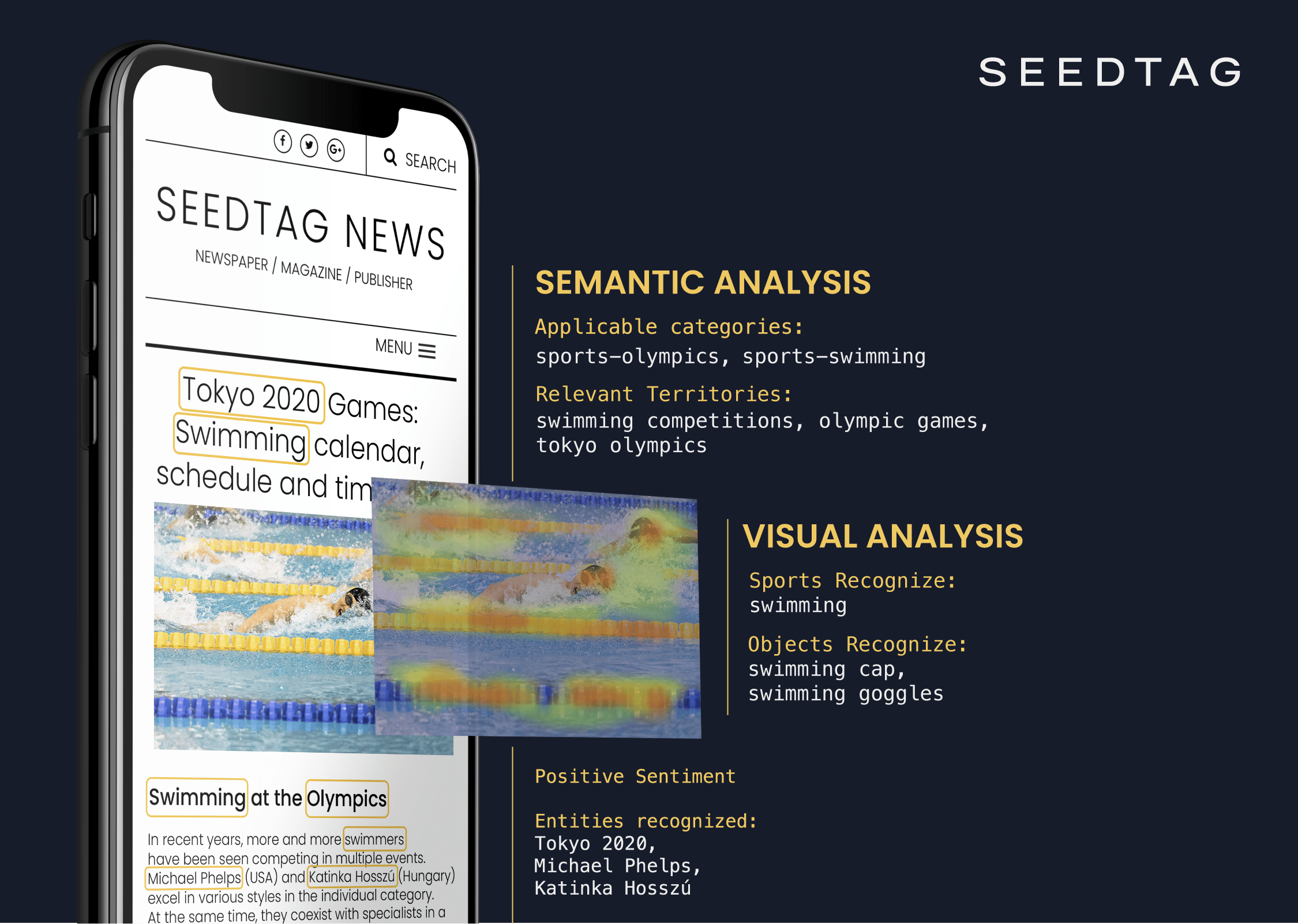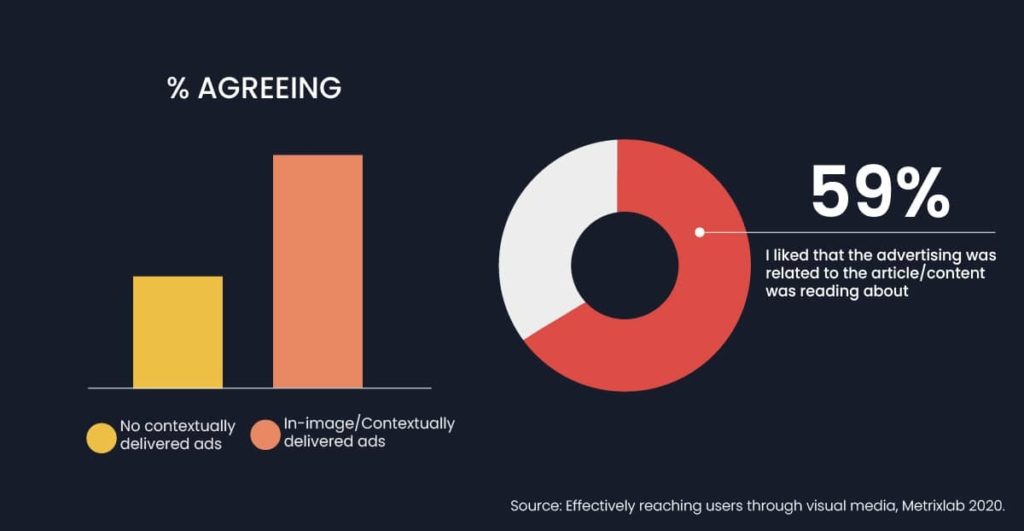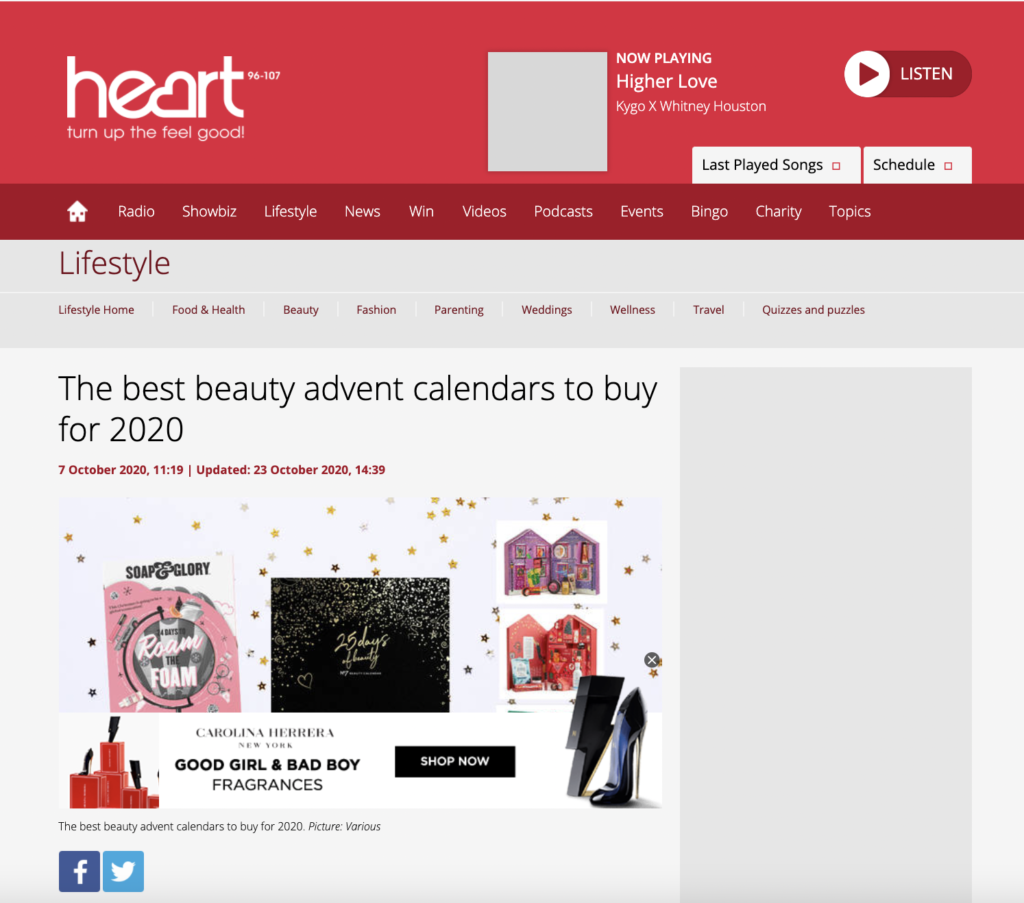
Contextual Advertising: AI's Answer to a Cookieless World
by Grace Dillon on 21st Jul 2021 in Deep Dive
Over the last 30 years, the digital advertising landscape has evolved immeasurably. Having adapted to audience responses to become much more targeted towards consumers, the industry has come a long way from its origins, where simple banner ads were seen as the most effective way to target audiences. Since then, we’ve witnessed the introduction of pop-up ads, ad blockers, in-image formats and even social media advertising. Times undoubtedly change, but so too have the tactics deployed by advertisers.
Seedtag has produced this Deep Dive special in partnership with ExchangeWire. Seedtag was founded in Madrid in 2014 by two ex-Googlers who wanted to get the most out of editorial images. The company’s technology combines the detection of thousands of features within text and images with the power of Machine Learning to provide human-like understanding of content. Seedtag's value proposition relies on innovative and disruptive solutions for agencies and publishers, as well as differentiated and unique creatives, made to measure and perfectly integrated into images and videos.
Evolving with the Consumer
When the first advert was published on hotwired.com in 1994, no one could be certain about how audiences would react as AT&T ventured into the unknown. It was simply a milestone moment that began the snowballing of what we know online advertising to be today.
The banner ad saw a huge 44% click-through rate (CTR), sending traffic to a series of AT&T ads narrated by actor Tom Selleck, guaranteeing a future where you could read books, get directions, send faxes, and do a multitude of other now menial-sounding tasks remotely.
These adverts may seem dated, from the ‘dark ages’ before we knew the luxury of having the whole world at our fingertips, and immediate answers at the click of a button. However, an advert receiving a 44% CTR is now unheard of. Today, a similar banner ad will average a CTR of just 0.1%. Consumers have become numb to efforts of the past, and advertisers are continually having to become even more creative in order to reach users — many of whom see ads as nothing more than an inconvenience.
Leave Third-Party Data Behind
It is clear that advertisers need to keep in line with consumer demands to find success. However, in today’s environment, that doesn’t only mean serving relevant ads that appeal to audiences, but with rising concerns over third party data, brands also need to be able to reach consumers without intruding on their privacy.
This battle for impressions, click-throughs, and — eventually — leads continues, but with many now becoming desensitised to the ads they are served online, it has never been more important to effectively target audiences with relevant content that stands out from the crowd.
While programmatic and cookie-based advertising has been heavily relied upon over the last decade, concerns over data privacy and the development of Artificial Intelligence (AI) have led to contextual advertising making a comeback.
AI leverages and analyses data to rationalise and act towards the best possible outcome of its goal. However, contextual AI takes this one step further — it utilises the power of Machine Learning to provide a human-like understanding of content. For brands, this means being able to serve relevant ads without the need for cookies or third-party data. Contextual advertising allows brands to engage with consumers within their universe of interest, while protecting brand safety at the highest level.
Letting machines do the work
Contextual advertising works by placing ads designed to target specific audiences on relevant websites. For example, a page that focuses on books — whether it’s a video, article, or online retailer selling them — will utilise the algorithms behind a contextual advertising solution to include relevant ads specific to the context of the page (such as sales ads for reading glasses or bookmarks).
By leveraging machine learning, a contextual advertising tool can use the information available — such as keywords, page types, phrases and media channels — to understand the context of the page and provide the most relevant and engaging communications without the use of cookies. Furthermore, these contextualising factors will include positive connotations (areas to link the advertising to) as well as negative ones (areas to avoid links being made). All of these physical links are then compounded together to build a tighter bond between the advert and the placement, making sure that everywhere an advert appears is relevant to its audience with the highest level of brand safety.
This automation in advert placement also saves a significant number of ‘man hours’, with machine learning’s automation capabilities picking and placing suitable adverts in relevant places far quicker than if the task was being completed manually.
Increased Brand Safety
While the goal for many is increased brand awareness, brand favourability is also an important aspect of advertising that organisations must be mindful of. By placing ads on negative content — plagiarised, false or negative articles, or negative reviews borne out of bias or insufficient evidence — brand favourability can drop by as much as 10%, according to research conducted by MetrixLab and Seedtag. Brands can quite easily be damaging their reputation through misplaced ads without even knowing it.

In comparison, the same study found that when running in-content contextual tools, brands are not only being associated with safe and relevant content, but their ads are also fully integrated into the article’s visual content, creating a halo effect on consumers. This was found to improve brand favourability by up to 22% — an impressive shift in the right direction.
By leveraging in-content contextual, organisations not only protect their brand, but can significantly enhance its favourability before target audiences have even clicked through.
Leave Behavioural Behind
Contextual advertising is an undeniably strong method of getting your message in front of the right consumer audience. However, it shouldn’t be confused with behavioural advertising.

Behavioural advertising does what it says on the tin — it selects adverts for users based on their browsing behaviour, finding the ads that are relevant to users from their past purchases, searches, or common visits.
However, whilst behavioural advertising hits people based on their searches and online browsing habits, it doesn’t have a way of placing the right ads into the right places, as contextual advertising does. Instead of product advertising appearing AFTER a search has been made, contextual advertising has the capabilities to find the right audience beforehand, meaning that the ad doesn’t end up becoming an afterthought and missing out on a whole group of viewers.
Contributing to Business Growth
Only 4 in 100 ads per day get more than one second of attention, and to stand any chance of being one of them, brands need to introduce ad personalisation to make the advertising completely relevant and personal to the viewer whilst respecting their privacy.

Having your adverts in the right place is a business-critical must in terms of building relationships between your adverts and viewers. We scroll approximately 90 metres every day on the internet, trawling through various types of content and media, and people switch their screens twenty times in an hour on average.
Contextual advertising is important for businesses to help build and maintain traction in their online advertising efforts. In an area where success is so difficult to come by, the best advertisers and marketers will be right on the cutting edge of technology, ready to pivot at any moment. Drawing back to the very first AT&T banner ads, the traction was so high simply because it was so new and fresh. New ideas and methods always draw higher traction and better results, so businesses that can be innovative and imaginative in their approach are more likely to find better results following an initial launch.
Looking to the Future
Contextual advertising will continue to develop and change as the world moves on. Far more is now based around smartphone layout, and websites being device-compatible. As of 2020, just over 50% of internet searching was undertaken on mobile devices (excluding tablet devices) as opposed to desktop or computer searching. Whilst this doesn’t directly change the way that contextual advertising works, it will change the way that adverts need to be presented. Placement on a site will become ever more important as users look for total ease when navigating a website or shopping page, and become increasingly frustrated and turn off a site when advertising is irrelevant or gets in the way.
Essentially, we would expect contextual advertising to be shifted by a cultural and attitudinal change in internet users. Advertising is going to have to become even more personalised, and even more user-friendly in order to still appeal to an ever more impatient and unforgiving audience.
As with many industries, pivoting to accommodate a more demanding client base will be on the agenda for the next year, five years, or maybe even decade. We shouldn’t expect to see contextual advertising’s form to shift dramatically, but rather changes to how it interacts with readers, and, ultimately, convinces readers to do what every advertiser wishes them to — engage with their ad!
The Numbers Behind Contextual Targeting
From the outside looking in, the success of an ad campaign often comes down to finances. How much did a brand invest? And how much of a return can they expect? Return on investment is clearly among the top-ranking KPIs, but there are a number of other considerations brands need to take into account when it comes to campaign successes.
Today’s digital-first environment can be easily manipulated: we are surrounded by misinformation, fake news, and unsafe content. With that in mind, brand image and favourability must also be a priority for any business executing a digital campaign.
Serving relevant ads to target audiences is the goal of any advertiser, but it should never come at the expense of brand safety. Fortunately, thanks to contextual targeting, that doesn’t have to be a concern. Instead, brands can not only remain protected, but they can significantly enhance their favourability, ensuring that ads are being associated with safe and relevant content while capturing attention, engaging more consumers, and producing positive reactions.
A Safer Approach
Negative content is the scourge of the online world. Naturally, brands want to avoid serving ads on the pages that host it. You may have read about how Apple never lets villains in films or TV shows use iPhones. It’s a very similar concept — brands want to remove themselves from these situations because of the negative connotations created merely by being associated with them. The same goes for online ads.
Fortunately, they can avoid negative content quite easily; by utilising contextual targeting, brands can serve ads on more appropriate content. This not only ensures stronger brand safety, but also helps them reach users who have a more positive mindset at the point of being exposed to these ads.
According to research undertaken by MetrixLab in conjunction with Seedtag, when ads were delivered without contextual targeting, 12% of respondents felt that the ad was on a webpage that made them feel negative about the brand. In comparison, only 5% of respondents felt this way when in-image ads were delivered through contextual targeting.
Creating Favourability
A recent TAG and BSI study of consumers’ attitudes and perceptions revealed just how important brand safety is. The survey found that over 85% of consumers would reduce or stop purchasing products they regularly buy if they discovered an ad for that product had run next to COVID-19 conspiracy theories or misinformation. The majority would do the same if a favourite brand advertised near hate speech (89%), malware (92%), illegal content (89%), or terrorist recruiting materials (93%). Negative content has a significant impact on consumer behaviour.

Clearly, it is highly important to keep brand safety in mind when placing ads. While contextual targeting allows brands to do this seamlessly, it also greatly enhances brand favourability.
MetrixLab and Seedtag found that when running in-content contextual tools, brands are not only being associated with safe and relevant content, but their ads are also fully integrated into the article’s visual content. This was found to improve brand favourability by up to 22%.
By overlaying contextual technology on ad buying, brands can ensure that any ads served are aligned with the content that target audiences are consuming at the exact time of exposure, which matches interest in real-time. As a result, brands create a safeguard and stronger fit between themselves and the content that they are serving ads into. 69% of MetrixLab and Seedtag respondents agreed that ads fitted the page when delivered through in-image contextual targeting. When delivered without contextual targeting, this number almost halved, dropping to 36%.
There is a positive correlation between ads and their relevance to the content they are being served with. IAS found that a staggering 70% of consumers believe that contextual advertising relevance is at least “somewhat important”.
These findings are reinforced by the MetrixLab and Seedtag study, where 59% of respondents also claimed that they liked the fact that the ads they were being served were related to the content they were reading about. The preference is clear, and this translates into deeper brand favourability and a stronger emotional response from consumers.
The ability to target audiences based on real-time content consumption works to the benefit of all parties: content providers, advertisers and consumers.
Strengthened Brand Impact
Contextual targeting keeps brands safe and favourable, but the placement also helps them to go the extra mile and be impactful as well.
Brands want to be remembered. Being safe and favoured does help, but it doesn’t necessarily make a company stand out. By utilising contextually targeted in-video ads, brands can create a significant increase in the performance of their campaigns. When compared to common video ads, contextually targeted in-video ads lead to stronger recall and memorability, helping to make advertising efforts land better with consumers and creating a stronger impact.
MetrixLab and Seedtag’s research found that message recall can improve by as much as four times that of in-video ads that are served without contextual advertising. Furthermore, brand favourability increases by 370% and purchase intent rises by 390%.
It’s a seemingly simple switch, but the results speak for themselves. Suddenly a brand is well remembered. Messages are not only delivered well, but received and recognised.
Context is Everything
Contextual targeting enables brands to improve the efficiency of their digital advertising, combining contextual AI and in-content advertising placements to deliver impactful campaigns. Successful brands utilise a consumer’s natural inclination to look at imagery that is featured within the content. As mentioned above, the research supports that claim, and contextual targeting provides the solution that enables this level of targeting directly.
Without relying on third-party data, contextual targeting reaches the right audiences at the right moment, helping to capture attention, drive stronger viewability, and maximise the impact of impressions. Consumers become engaged; they spend more time on contextually targeted ads and offer brands a better opportunity to communicate their messages effectively. Contextual targeting also produces more positive reactions, and brands can generate stronger feelings and emotions that lead to improved purchase intent. Despite all of this, brand safety still remains firmly intact.
Carolina Herrera: A Festive Success
Towards the end of 2020, Seedtag partnered with Carolina Herrera, part of the well-known fashion and fragrance business, Puig Group, to increase awareness of its fragrances — Good Girl and Bad Boy — in the build-up to the festive period.
 The main focus of the collaboration was to position the brand and its perfumes at the top of consumers’ minds as the holiday season — the biggest and most important retail season of the year — approached. Targeting men and women who were specifically interested in retail consumer goods and arts, Carolina Herrera wanted to work with a contextual advertising company that provided a precise targeting strategy. This would allow the brand to capitalise on all premium Christmas and gifting content in the UK’s leading lifestyle publications.
The main focus of the collaboration was to position the brand and its perfumes at the top of consumers’ minds as the holiday season — the biggest and most important retail season of the year — approached. Targeting men and women who were specifically interested in retail consumer goods and arts, Carolina Herrera wanted to work with a contextual advertising company that provided a precise targeting strategy. This would allow the brand to capitalise on all premium Christmas and gifting content in the UK’s leading lifestyle publications.
Understanding the Audience
The Carolina Herrera campaign was thoroughly researched and planned by Seedtag. As soon as the project was launched, Seedtag worked with MetrixLab to conduct a brand lift study, allowing it to examine how respondents were exposed to a piece of advertising content that leveraged a contextual strategy. Through this study, the respondents were exposed to the Carolina Herrera ads in a natural, unforced manner. By collaborating with a third party for research, Seedtag was able to provide Carolina Herrera with reliable and conclusive evidence that the campaign would achieve the expected results.
To give the most precise results, it was important to Seedtag that respondents were split into two groups: controlled and naturally exposed. This enabled Carolina Herrera to understand exactly how effective a contextual targeting strategy was to its online target audience.
Metrixlab was also able to compare the brand against big players in the perfume industry such as Chanel, Dior, and Dolce & Gabbana. Overall, the respondents saw a strong fit between the brand and the website content.
Ads with a Purpose
As Carolina Herrera wanted to increase awareness of its fragrance, the implementation of the campaign revolved around the positioning of both perfumes to put the product at the top of consumers’ minds during the holiday season. In order to accomplish this, Seedtag led the project with in-image formats, with ads being skippable from the first second of entering the page. This allowed Seedtag to assess how the display format of the image affected the behaviour of audiences. The project executed a combination of Seedtag’s display solutions, including:
- Contextual Impact Display — generating a qualitative first impact and capturing user attention taking up 100% of the image space
- Contextual Engagement Display — driving traffic to sites across Fashion and Gifting environments
Seedtag also utilised its in-house design team to create assets that maximised the association and integration of the brand into the desired context. Seedtag was also able to create the brand perception of being ‘the perfect gift this Christmas’, highlighting its success as a campaign. The project was also able to showcase an increase in unaided brand awareness and favourability, as well as image performance and associated messages.
A Festive Success
Overall, the campaign significantly increased the association of the brand with the key message “the perfect gift this Christmas”. Test results showed that the Good Girl Supreme Contextual Engagement Display was the best performing and most well-received creative, as it was unique and drove brand interest to purchases at Christmas – helping Carolina Herrera to capitalise on premium Christmas and gifting content. The advertisement also grew website traffic, and at the end of the campaign, Seedtag was able to provide expert advice to Carolina Herrera on how the organisation could continue to push to be a stronger brand and convert online shoppers into customers.
Main results include:

The campaign for Good Girl and Bad Boy was able to capture the attention of targeted, online users and increase the advertising recognition of the brand without the use of cookies. Online advertising and message recall also increased substantially, meeting the brand’s original objective of becoming top-of-mind for consumers during the holiday period. The project proved to be an effective spontaneous awareness campaign for Good Girl and Bad Boy by Carolina Herrera.

 Download Report
Download Report 






Follow ExchangeWire